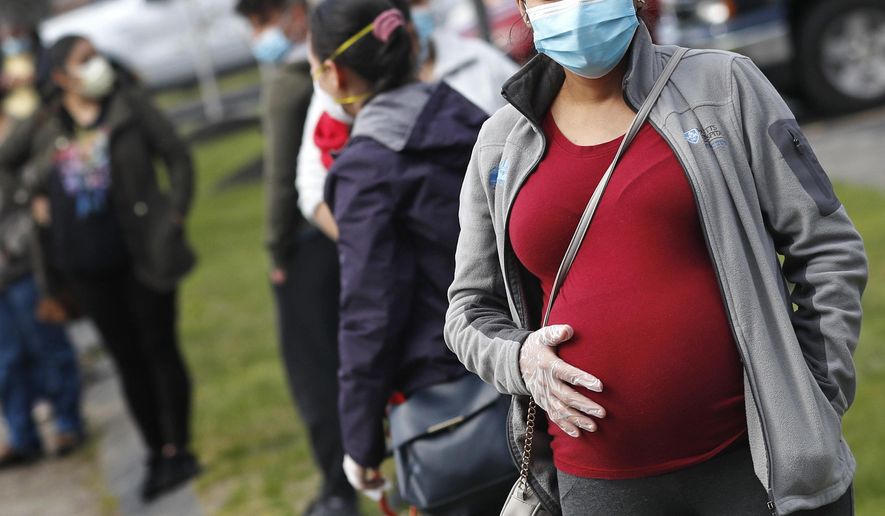The COVID-19 pandemic has slashed fertility rates to their lowest point in U.S. history. Still, the experts at the Social Security Administration, who are deeply invested in the issue, say the decline is just a blip and women are merely deferring children to later years.
The total fertility rate, a measure of births a woman is projected to give in a lifetime, will dip to 1.54 this year and stay low at 1.64 next year. But Social Security’s trustees said in a report last week that they expect the rate “will be fully made up for by increased rates” in the years afterward.
“In other words, the pandemic will cause a number of women to defer childbearing from 2021-22 to 2024-26,” the trustees concluded.
Birthrates have been among the closely watched markers of the pandemic. Combined with morbidity rates, they are among the most important in the long run. A lasting birth dearth means fewer workers to support retirees in the second half of the century.
Social Security’s trustees have an optimistic take. In fact, they predict the rates will come roaring back even beyond the lows and highs of the pandemic and its immediate aftermath. The fertility rate should reach 2 per woman by the mid-2050s, the trustees said. That rate hasn’t been reached since 2009, when the U.S. was mired in the Great Recession.
Stephen C. Goss, Social Security’s chief actuary, said the rate of the past decade was probably an aberration and women on average say they want to have at least two children.
Others are more pessimistic.
The Congressional Budget Office sees a lasting birth dearth, with 130,000 fewer births each year this decade and 160,000 fewer births each year in the subsequent two decades.
That means hundreds of thousands fewer people in the labor force to support retirees toward the end of the century.
In its long-term budget outlook released in March, the CBO said the total fertility rate will rise for the rest of this decade, once the pandemic is over, to 1.85 births per woman in 2029 and remain there for the coming decades.
If the CBO is right, the big social safety net programs will have problems.
Chuck Blahous, a former Social Security public trustee, said there is reason to be skeptical that birthrates will come roaring back the way the trustees project.
“We haven’t had it at that level throughout the last decade,” he said in an online briefing on the trustees’ report at George Mason University’s Mercatus Center. “It surprised me a bit, and if I had to bet on whether things are going to be worse or better than projected in this report, I would probably bet they would be worse.”
He said the trustees’ report was bad even with the optimistic birthrates.
The trustees projected that Social Security’s trust funds will be exhausted in 2034. As the law stands, the program will be able to pay out only what it generates from taxes. That is projected to be just 78 cents for every dollar in promised benefits and a few cents less in later decades.
Birthrates are at the heart of the calculations.
Mr. Goss said that if women continued to have children at rates of the past, then plenty of workers would be available to support Social Security beneficiaries.
“Our big shift in the cost of Social Security over the long term is because of the change associated with birthrates,” he said in the Mercatus Center briefing.
It plays out in big ways.
From 1990 to 2008, Social Security benefits amounted to about 4.2% of gross domestic product. Given current benefits and the expected labor force, the number will rise to about 6% and then stabilize toward the end of this century.
Mr. Goss said it boils down to simple math: Do Americans want to pay the taxes to fund that higher rate, cut benefits to return the rate to 4%, or combine tax increases and benefit cuts to find a middle ground?
The 2021 trustees’ report is the first to take account of the COVID-19 pandemic. Mr. Goss said the Social Security Administration will closely watch fertility rates to see whether they rebound as he projects.
He said the pandemic also has affected the other end of the demographic curve, with death rates rising.
Among those 15 and older, the rate for 2020 increased by 16.4%. For 2021, it will be 15% higher than previously thought. Projections improve after that, with death rates only 4% higher next year and 1% in 2023.
Among those 14 and younger, mortality rates are falling. Social Security predicts a 14% decrease in 2020, 10% this year and 2% next year.
That works out to an overall increase. Death rates have been steady at just above 800 per 100,000 people over the past decade. The number reached 925 last year and was expected to be 900 per 100,000 people this year.
Projections improve by 2023, with the rate dropping below 800 deaths per 100,000 people.
That is both good and bad news.
“As good as it will be for all of us to live longer, it’s bad for the finances for Social Security or for any pension, for that matter,” Mr. Goss said.
• Stephen Dinan can be reached at sdinan@washingtontimes.com.




Please read our comment policy before commenting.